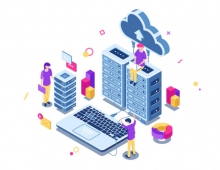
IBM and SAP Demonstrate New Cloud Technology: Real-Time Application Mobility
In a joint demonstration at CeBIT, IBM and SAP previewed a technology that enables the live migration of SAP applications across remote IBM POWER6 systems via cloud computing.
The technology, developed as a part of the European Union-funded RESERVOIR cloud computing project, is designed to provide companies with a range of cloud computing solutions to meet their specific business needs.
Cloud computing is an emerging approach to shared infrastructure in which large pools of systems are linked together to provide IT services. This approach to delivering and consuming IT provides answers to the challenges many businesses face today: the immense complexity of sprawling data centers, the growing cost of energy, and the need to dynamically adapt the allocation of IT resources to constantly changing workloads and business priorities.
In this technology demonstration, IBM and SAP show how users can run enterprise applications in the cloud, in particular demonstrating the migration of workloads across physical servers and across data centers.
"The breakthrough we're showing today is that applications can flexibly move across remote physical servers, regardless of location -- which makes our work a strong enabling technology for the cloud," explained Dr. Joachim Schaper, VP EMEA of SAP Research. "Specifically, in cloud-scale environments, service providers will need to provide users with access to services across the cloud. Service providers will need to compete on performance and Quality of Service -- and so the future cloud will need to support application mobility across disparate data centers to enhance performance."
"With RESERVOIR, our aim is to provide cloud technologies that will enable energy-efficient, borderless delivery of IT services that are driven by actual demands -- with the goal of keeping costs competitive," said Dr. Yaron Wolfsthal, senior manager for system technologies at IBM's Research Lab in Haifa, Israel, where the technology was developed. "The new technology is allowing us to realize the vision of true cloud computing by moving applications across disparate interconnected networks to optimize load balancing across remote servers. When changes in workload occur, the new technology autonomically balances resource utilization and power consumption across remote servers. This is done, for example, by evacuating and turning off under-utilized servers (and possibly entire data centers) when demand drops, and powering on idle servers when load increases."
In this demonstration, the migration of SAP workloads across the cloud is supported by IBM's POWER6 systems, which enable users to run separate applications on different virtual machines, called logical partitions, on the same physical server. The IBM POWER6 system's Live Partition Mobility capability further allows for the movement of a partition from one POWER6-based server to another POWER6-based server in the data center with no application downtime, resulting in better system utilization, improved application availability, and energy savings.
Cloud computing is an emerging approach to shared infrastructure in which large pools of systems are linked together to provide IT services. This approach to delivering and consuming IT provides answers to the challenges many businesses face today: the immense complexity of sprawling data centers, the growing cost of energy, and the need to dynamically adapt the allocation of IT resources to constantly changing workloads and business priorities.
In this technology demonstration, IBM and SAP show how users can run enterprise applications in the cloud, in particular demonstrating the migration of workloads across physical servers and across data centers.
"The breakthrough we're showing today is that applications can flexibly move across remote physical servers, regardless of location -- which makes our work a strong enabling technology for the cloud," explained Dr. Joachim Schaper, VP EMEA of SAP Research. "Specifically, in cloud-scale environments, service providers will need to provide users with access to services across the cloud. Service providers will need to compete on performance and Quality of Service -- and so the future cloud will need to support application mobility across disparate data centers to enhance performance."
"With RESERVOIR, our aim is to provide cloud technologies that will enable energy-efficient, borderless delivery of IT services that are driven by actual demands -- with the goal of keeping costs competitive," said Dr. Yaron Wolfsthal, senior manager for system technologies at IBM's Research Lab in Haifa, Israel, where the technology was developed. "The new technology is allowing us to realize the vision of true cloud computing by moving applications across disparate interconnected networks to optimize load balancing across remote servers. When changes in workload occur, the new technology autonomically balances resource utilization and power consumption across remote servers. This is done, for example, by evacuating and turning off under-utilized servers (and possibly entire data centers) when demand drops, and powering on idle servers when load increases."
In this demonstration, the migration of SAP workloads across the cloud is supported by IBM's POWER6 systems, which enable users to run separate applications on different virtual machines, called logical partitions, on the same physical server. The IBM POWER6 system's Live Partition Mobility capability further allows for the movement of a partition from one POWER6-based server to another POWER6-based server in the data center with no application downtime, resulting in better system utilization, improved application availability, and energy savings.





















